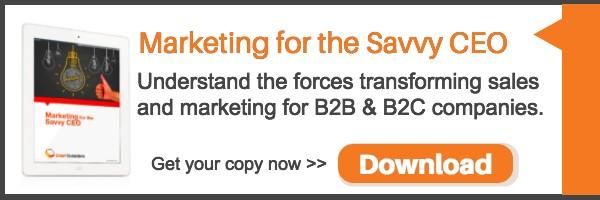CEO Blog - Advice for CEOs on growth and scaling
Moving to a Blue Ocean With Growth Gears: Five Steps to Chart a Course for Success

Whether you are a seafaring sort or not, it’s fairly intuitive to expect that a peaceful, sparkling, blue ocean is much more navigable than one roiled by rolling tides, scary sea vermin and dangerous storms.
This relatable parable constitutes the foundation of “Blue Ocean Shift: Beyond Competing - Proven Steps to Inspire Confidence and Seize New Growth,” a book by W. Chan Kim & Renée Mauborgne which provides a series of waypoints by which to guide businesses into calmer seas.
I recently successfully led a client through the Blue Ocean Shift process prescribed by Kim and Mauborgne, and realized how well the lessons align with similar ones espoused in “The Growth Gears,” a book authored by my Chief Outsiders colleagues Art Saxby and Pete Hayes. “The Growth Gears” does a terrific job of building a process around how to go from random acts of marketing, to a purpose-based method of marketing an organization, by following three pillars—Insights, Strategy and Execution.
Similarly, Blue Ocean Shift encourages the same type of deep, strategic, corporate soul-seeking—using the same three waypoints by which to sail to success.
Executing a strategic growth process is not an overnight task. It requires a commitment to touching upon the three aforementioned pillars, as well as a true commitment to flexibility – something Kim and Mauborgne call “organization strategy trumps structure.”
Over the course of the three blogs, I will take you through the process I use to help sail enterprises into calm waters. You will find that both books mentioned here offer a complement of effective tools and processes that will help you to challenge the status quo, and put your organization on the path to growth.
Let’s dive in by talking about Growth Gear No. 1 – INSIGHTS. Below are five actions I take when leading clients from a red ocean to a blue ocean:
1. Voice of Employee (VoE): When I start engagements, I lead workshops with the key stakeholders of the organization to understand their collective superpower – the “why.” Aligning everyone around the same purpose is paramount to delivering great client service, great value-based products, and great strategic results. The “why” can help drive the value proposition, brand promise and key messaging as a rallying cry for internal and external customers. I also believe surveying and interviewing this group paints a focused picture of the current state of the organization.
2. Voice of Customer (VoC): Reaching out to current and past clients through surveys and phone interviews is key to gaining further insights into the value your company offers, and how it is perceived. It also is a great way to check your internal “group think.” During this exercise, it is worth becoming reacclimated with your clients’ pain points, as well as what alternatives they have pursued to mitigate their reliance on your products or services. In “Blue Ocean Shift,” Kim and Mauborgne encourage using a Buyer Utility Map to assist teams in getting a snapshot of industry forces that may be affecting the appeal for your products, and similar offerings in your industry. This tool is a great way to uncover opportunities the industry has not considered, while helping to identify likely buyers from disinterested “tire-kickers” in your legacy database.
3. Competitive Strategy Canvas: This is a one-page Blue Ocean Shift visual map that will help you identify where you and your competitors are expending the most resources in the bid for customers. By completing this map, you will quickly identify what is making your industry a “red ocean” of competition. By developing the key competitive factors from a buyer’s point of view, you’ll find this map will come alive. Armed with this data, you can then rank your company against its competitive interests using a 5-point Likert-type scale. Ultimately, you will want to focus on how to manage against your two most dominant rivals or industry, as identified by this map.
4. Competitive Online Research: There are so many ways to get insight to what your competitors and the industry are doing by doing simple research on-line. Below are a few things I do to get insight:
- Review Competitive Websites
- Find out what they use to support their value proposition, brand promise, claims and testimonials
- Review their website news section to determine their activity
- Utilize free tools to understand their digital presence.
- Follow their social media channels (I find that Hootsuite is a good tool to aggregate social media feeds) and review current activity by industry, competition and offerings.
- Review their LinkedIn presence, with an eye toward reviewing their contacts, employee growth and job openings
- Review Glassdoor to understand the workplace dynamics
- Review Industry blogs, forums, associations, events to uncover trends and influencers
- Review top global trends to find intersecting interest
5. “Walk the Room”: It’s critical for the senior leadership team to “get out” into the universe of consumers, and walk in their shoes. Find ways to walk through your business as a customer would – experiencing the entirety of the buying journey. Gather insights on what it takes to deliver a great client experience. Additionally, make yourself a fixture in professional associations and industry events to get a first-hand understanding of what trends are coming your way. Finally, schedule time to visit with key clients – perhaps a tour of their work site, lunch meeting, or some other casual setting. Clients will be much more candid in person than on the phone.
If you are going to be the master of all you survey, it’s hard to do it from the throne. You need to get out and get involved.
Once you complete these five steps, you will have a much more insightful understanding of your company, how it’s perceived, and its role in the marketplace moving towards a blue ocean. Ready for the next step? Stay tuned for our next blog, which will focus on the Strategy Growth Gear.
Topics: Marketing Strategy, Growth Gears, Strategic Planning
Thu, Jun 20, 2019Related Articles

- Press Releases
- Careers
- Case Studies
- Marketing Consultant Company
- Marketing Strategy Consultants
- Marketing Plan Consultants
- B2B Marketing Consultants
- Virtual CMO
- Marketing Consultant Outsourcing
- Fractional CMO
- What is a Fractional CMO
- Healthcare Marketing Consultant
- Marketing Consultant Houston TX Texas
- Marketing Consultant Texas TX
- Marketing Consultant Bay Area
- CEO Blog
- Ebooks Plus
- Executive Marketing Consultants
- Product Marketing Consultants
- B2C Marketing Consultants
- Virtual Marketing Consultants
- Senior Marketing Consultants
- Temporary CMO
- Hire a CMO
- Fractional CMO Salary
- Fractional CMO Responsibilities
- Marketing Consultant Austin TX Texas
- Marketing Consultant Dallas TX Texas
- Marketing Consultant San Antonio
- Helping Private Equity
- Private Equity Blog
- Leadership Team
- Privacy Policy
- Business Marketing Consultants
- Strategic Marketing Consultants
- Marketing Technology Consultants
- Sales and Marketing Consultants
- CMO Job Description
- CMO Salary
- Fractional CMO Agency
- Fractional CMO Services
- CPG Marketing Consultant
- Marketing Consultant San Diego
- Partners
Houston, TX 77056
© 2023 Chief Outsiders


